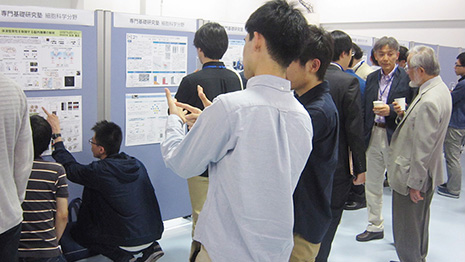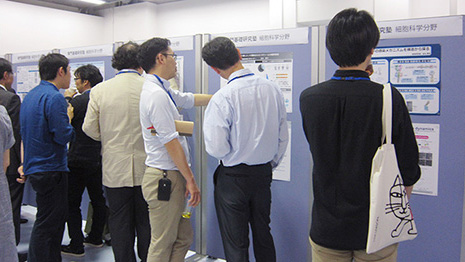News
2019-6-13
The Establishment of the Organization for Fundamental Research is Celebrated with an Opening Ceremony
On May 24, 2019, an opening ceremony was held to mark the inauguration of the Organization for Fundamental Research (CFR). Held at the Building S8 lecture hall, Suzukakedai Campus, more than 100 people participated in the event, including President Masu, Executive Vice Presidents, Excecutive Auditors, Deans, Administrative Managers, and staff and members of the organization, as well as journalists representing a range of media outlets.
Opening remarks: Dr. Fumio Koyama, Director of CFR
The CFR was established last year with support from the Ministry of Education, Culture, Sports, Science and Technology (MEXT). The aim of this organization is to foster outstanding young researchers. The organization will implement two programs: a Specialized Academy for outstanding young researchers to study in their specific field over a period of several years, and a Comprehensive Academy that provides newly appointed assistant professors with an opportunity to consider and refine new research plans for three months. As of this financial year, these Academies are now up and running. To mark the occasion of program commencement we are holding this opening ceremony today.
Greeting: Dr. Masu Kazuya, President of Tokyo Tech
Thank you very much for joining the CFR opening ceremony at our university today. In particular, I would like to thank the media for covering the opening of this important program.
About two years ago, when I summarized the concept of a designated national university corporation for our university, I strongly felt that a concrete and sustainable system was essential to foster young researchers who would be responsible for leading-edge science and technology. At around the same time, Professor Yoshinori Ohsumi was awarded the Nobel Prize in Physiology or Medicine. Professor Ohsumi is a committed advocate for basic research: he speaks of the need for universities to provide an environment in which people can immerse themselves in basic research. For this to occur, society needs to support basic research as a cultural activity.
With the support of the MEXT, we have established the CFR as a framework within which young researchers can immerse themselves in basic research, which is extremely meaningful and gratifying for our university. As the CFR employs a new and original strategy, I would like to ask the Director, the Headmaster of each Academy, and others involved in the organization to carefully track how the Specialized and Comprehensive Academies develop into the future. We hope that each academy member will play an active role in the future of science and technology in Japan. Thank all you all for participating today, and for your interest in and continued support for the activities of the organization.
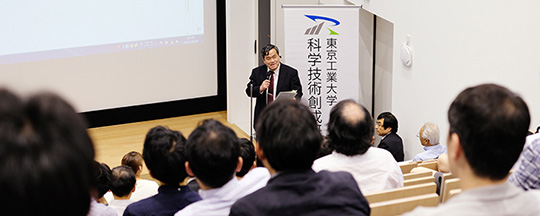
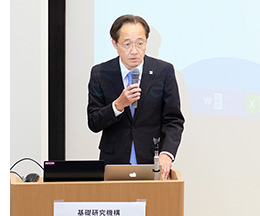
Overview of CFR: Dr. Naoto Ohtake, Headmaster of Comprehensive Academy
I’d like to give a brief overview of the CFR. Tokyo Tech was awarded nomination as a designated national university in March last year. Basic research and the social integration of research outcomes are two key components of cutting-edge research programs that are specific objectives for our university. It is vital that the interface between research and society is strong, and that the outcomes of social integration of research are fed back to basic research through university governance, informing relevant training of young researchers. To this end, a core aim of this organization is to increase the time that young researchers are able commit to research from the current average of around 60% to 90%, allowing complete immersion in research. We have therefore established the Specialized Academy, in which members are able to spend several focused years working on their research projects. We have also set up the three-month Comprehensive Academy, where junior faculty members from diverse research fields can come together and think about their future research and its implications for society.
Recently, the MEXT raised three critical challenges currently facing universities: the availability of research funding and time, the research environment provided to researchers, and the decline of research centers. We are taking measures to deal with each of these potential problems. In terms of research funding, the University recently launched the Yoshinori Ohsumi Basic Research Support Program, which provides yearly support to six young researchers. With regard to research time and the research environment, we have developed the CFR to address these problems by providing more research time to researchers, enhancing our research environment by promoting intellectual independence, and facilitating exchange and collaboration between top-level researchers from different background and disciplines. Our policy to allow young researchers to commit 90% of their time to research, establish open laboratories, and enhance administrative and technical support goes a long way in addressing the time constraints facing researchers on the ground. We are also implementing cultural shift to evaluate researchers based on their originality and unique approach to research, along with providing the time and space to develop and implement their research. To enhance exchange between researchers, we will facilitate interactions between younger and top-level researchers so that junior academics are able to learn from the experience of inspirational leaders that deeply understand the interface between science and technology.
The Specialized Academy fosters young researchers in highly specialized fields. In October last year, the Specialized Academy in Cell Science was established with Professor Yoshinori Ohsumi as its Headmaster, and there are now 14 academy scholars. In April of this year, the Specialized Academy in Quantum Computing led by Professor Hidetoshi Nishimori was set up, which so far has two scholars. Meanwhile, the Comprehensive Academy provides a generous opportunity for new faculty members of all schools of the university to think about their own research directions over three months, regardless of their specialty. This year, 29 members will be participating in the Comprehensive Academy. This program is unique, providing opportunities to develop research themes through a meeting with Professor Yoshinori Ohsumi and multiple workshops to think about the connection between research and future society. We hope that these opportunities will facilitate the growth of all members of these Academies.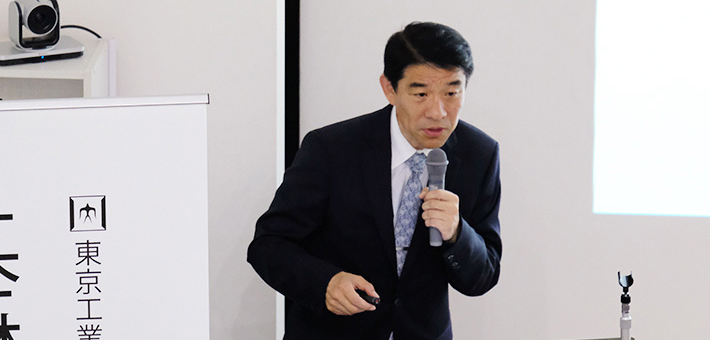
The Importance of Basic Research: Dr. Yoshinori Ohsumi, Headmaster of Specialized Academy
Unfortunately, basic research is devalued in today's society, with efficiency often prioritized.
Selection and concentration have made it more difficult to obtain research funding, resulting in an inclination towards exit-oriented research. Postgraduate doctoral students in Japan used to be critical drivers of basic research, but due to declines in the number of postgraduate doctoral students, basic research is now in a critical situation. In addition, there is strong movement to favor tasks that are likely to show results, irrespective of their importance or novelty, rather than the prosecution of challenging research. The problem with Japan's human resource development system is that students want to become experts quickly, while companies are suffering from a strong sense of stagnation. On the other hand, in the past few years I have visited other countries and was struck by the motivation of young people in Switzerland and Germany, stimulating conversations with researchers in the US, excellent core facilities in the UK, speedy construction and the energy of the younger generation in China, and numerous other examples.
The aim of the Specialized Academy is to develop outstanding researchers who will lead the future of research in Japan. I believe that a major challenge facing those involved in the CFR is to extract cell science research issues from their own academic interests and formulate and test hypotheses in a relaxed research environment.
The mission of the CFR is to provide the promote:
(1) The enjoyment and importance of exchange
Efforts to understand and respect each other's research. The opportunity to be exposed to good research and understand different ways of thinking and perspectives by taking an interest in other people's studies and enjoying and admiring good work.
(2) Research organizations that make the most of researchers
An environment where young people can conduct research freely, with a full range of common facilities and easy to use systems. Establishment of facility support systems with highly skilled engineers supports the curiosity of scholars and the creation of new collaborative research, resources that are critical for future researchers in the AI age.
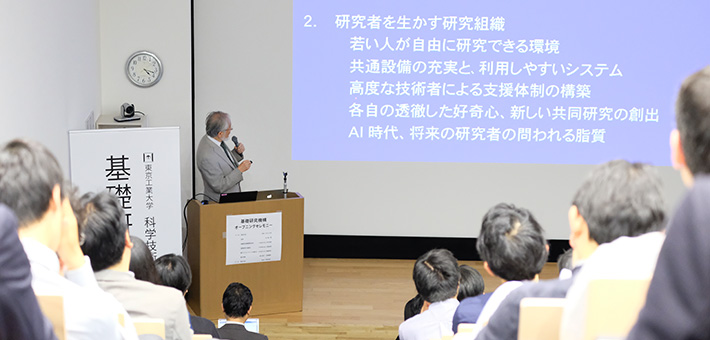
Interest in Quantum Computing -Wonder is Useful: Dr. Hidetoshi Nishimori, Headmaster of Specialized Academy
I visited a company in China yesterday. I thought the chairman was the same age as me, but most of the executives were in their 40s and are very positive. The Chairman made clear that they value basic research as the root of open innovation and as the function of universities in society.
Dr. Akito Arima, former president of the University of Tokyo, recently held a lecture for junior and senior high school students aiming to participate in the International Mathematical Olympiad, which Dr. Yoshinori Ohsumi and I attended. Here is how I explained the concept of quantum computing. In the macroscopic world, the properties of waves and particles are clearly separated, but in the world of quantum mechanics, the properties of waves and particles appear simultaneously. For example, an electron has no size, but it has mass and charge, so it is a particle in that sense. However, if you keep shooting electrons one by one through a slit from an electron gun, you will see interference fringes after a while, so it is a wave in that sense.
Electrons are characterized by spinning. Two spinning directions, clockwise and counterclockwise, are possible, and a single electron can have two states at the same time. The application of these principles in computing is quantum computing. In a superconducting state, a current flows independently in a circuit without the application of voltage, and since there are clockwise and counterclockwise directions at the same time, one bit can be represented by this flow. If you can represent 40 bits in a circuit, you've described a trillion states. If we can get the information we need from this configuration, we have built a functional quantum computer. One means of achieving such a computer is quantum annealing, which has already been demonstrated practically and can be used in optimizations such as the traveling salesman problem, where solutions can be derived in a very short time. In one application, Associate Professor Ohzeki of Tohoku University's Quantum Annealing Research and Development Center is using quantum annealing to simulate optimal evacuation routes from a tsunami.
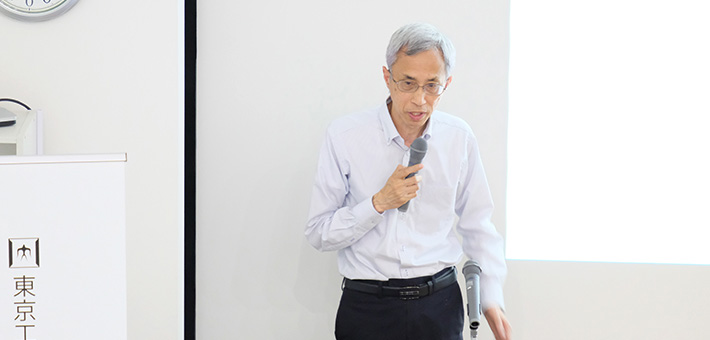
Research Talk from academy scholar: Dr. Tomoko Horie, Assistant Professor
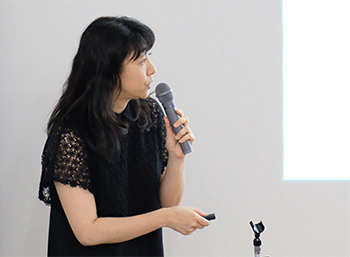 There are genetic and biochemical approaches to the study of autophagy. In the former case, Dr. Yoshinori Ohsumi's research, which involved the identification and functional analysis of the autophagy-related proteins through the screening of genetic mutants, was a remarkable achievement that led to the award of the Nobel Prize. On the other hand, there has been almost no progress in the biochemical analysis of autophagy in the 27 years since Dr. Ohsumi discovered autophagy in yeast. With recent improvements in mass spectrometry, it has become possible to analyze the proteome, lipidome and metabolome of cells, and thereby the detailed biochemical functions of autophagy. My research focuses on this important area.
There are genetic and biochemical approaches to the study of autophagy. In the former case, Dr. Yoshinori Ohsumi's research, which involved the identification and functional analysis of the autophagy-related proteins through the screening of genetic mutants, was a remarkable achievement that led to the award of the Nobel Prize. On the other hand, there has been almost no progress in the biochemical analysis of autophagy in the 27 years since Dr. Ohsumi discovered autophagy in yeast. With recent improvements in mass spectrometry, it has become possible to analyze the proteome, lipidome and metabolome of cells, and thereby the detailed biochemical functions of autophagy. My research focuses on this important area.Research Talk from academy scholar: Dr. Yuki Bando, Postdoctoral Fellow
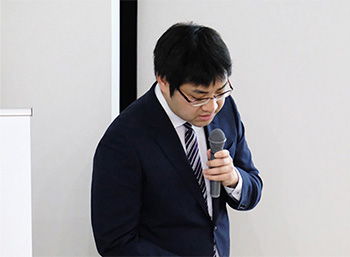 Quantum annealing solves the Ising Hamiltonian function, a Hamiltonian function developed for annealing states occurring during a finite time (annealing time). It is known that the annealing time depends on the energy gap between the ground and excited states, and that the energy gap occurs in the phase transition of the material. First-order phase transitions with small energy gaps are undesirable for quantum annealing because they increase the annealing time. My work involves the development of a secondary phase transition with a large energy gap.
Quantum annealing solves the Ising Hamiltonian function, a Hamiltonian function developed for annealing states occurring during a finite time (annealing time). It is known that the annealing time depends on the energy gap between the ground and excited states, and that the energy gap occurs in the phase transition of the material. First-order phase transitions with small energy gaps are undesirable for quantum annealing because they increase the annealing time. My work involves the development of a secondary phase transition with a large energy gap.Closing remarks: Dr. Norio Ino, Associate Director of CFR
Thank you very much for taking time out of your busy schedule to attend today. I would also like to thank the lecturers for their speeches. The Organization for Fundamental Research’s two main pillars, the Specialized and Comprehensive Academies, have been established with the important aim of cultivating human resources. It goes without saying that an environment in which young researchers are able to conduct original research with a well-considered, long-term perspective is important for the future of research in Japan. It will take time to create this kind of research environment and to produce results, and we would like to ask for your continued warm support as we do our best to support our future researchers.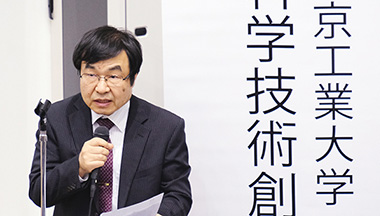
Press Conference, Poster Presentation and Exchange Meeting
After the opening ceremony, a 30 minute Q&A session was held between President Masumi, Dr. Ohsumi, Dr. Nishimori and Dr. Ohtake, and members of the media. Afterwards, participants moved to the open space on the first floor of Building S1, and a poster presentation and exchange party were held from 6:00 p.m. The more than 60 participants had enthusiastic discussions in front of the 21 posters presented, as well as discussing the future direction of the Organization and the university.
